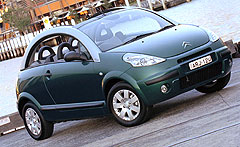Plenty of pizazz in Pluriel
BY BYRON MATHIOUDAKIS | 15th Sep 2004

Christened C3 Pluriel, the front-wheel drive, sometime three-door, four-seater light car is based on the platform of the five-door C3, with which it shares 60 per cent parts commonality.
Priced from $31,490, the single-model Pluriel is $6500 more expensive than the regular top-line C3 hatch.
But it does undercut the larger and less accommodating Peugeot 206CC Coupe-Convertible by $4500, and offers a more practical alternative to Daihatsu’s diminutive $29,990 Copen two-seater and the $37,990 Smart Roadster.
Two ‘closed’ and three ‘open’ Pluriel permutations are permissible: Three-door hatchback with a split lift and drop-down tailgate.
Three-door hatchback with Citroen’s ‘Panoramique’ sliding windscreen-to-rear window sunroof.
Two-door cabriolet-style roofless system.
Two-door convertible with all side and roof-railing structures removed.
Two-door convertible ‘utility’ – with folded rear seats and a drop-down tailgate.
The roof and rear window panels have a specially designed storage spot underneath the boot floor, although the large removable arched side panels cannot be transported within the car except when in place.
Citroen says the Pluriel, whose concept and name first graced a 1999 show car, was designed as a convertible from the onset, so developed the detachable roof and split-tailgate system in order to make it a convincing three-door hatchback.
Much is made of the 1177kg Pluriel’s upgraded strength, safety and security properties compared to its regular C3 donor car.
The body shell, pillars, side arches and sub-frame have been beefed-up (some with aluminium and/or very high strength tensile steel), while reinforced steel sits inside the rear headrests and backrests to help resist rollover deformity.
It all adds 130kg to the weight of the Pluriel.
Underpinning this is the standard fitment of anti-lock brakes, electronic brake-force distribution and brake assist, and dual front and front head/chest side airbags. The company says the Pluriel scores a Euro NCAP four-star impact rating, which currently puts it ahead of any other drop-top tested by the organisation.
A new 32-bit computer using digital multiplex electrics controls much of the Citroen’s more complex features, such as the retractable roof system and air-conditioning system.

Citroen says the Pluriel is capable of a 0-100km/h time of 11.6 seconds on its way to a 185km/h top speed. A European-test average of 5.5L/100km has also been achieved.
The only transmission on offer is Citroen’s controversial Sensodrive five-speed clutchless manual gearbox, also found on the C3 and C2 models. It is the only transmission fitted to the TU5JP4 engine.
But with Citroen’s ongoing commitment to diesel engine technology, the upcoming still-secret turbo-diesel four-cylinder unit earmarked for Europe should not be discounted for Australia.
The Pluriel uses the C3’s MacPherson strut and coil springs front suspension, but a dedicated transverse beam suspension set-up out back. And like its brethren, the rack and pinion power steering system is electrically assisted.
Regular C3 owners will also feel at home inside, with virtually identical cabin architecture shared between models. Some of the Pluriel’s more unique interior features are the two-person rear seats and hollowed-out front ones for increased rear passenger space.
Comfort features include power windows, remote central locking, electric mirrors, a CD player and cloth trim.
Local Citroen distributor Ateco Automotive does not envisage having any trouble hitting the 30 unit monthly sales targets.
"In fact supply is an issue at the moment," said company spokesman Edward Rowe, adding that the first two boat loads were already accounted for.
The C3 Pluriel is not the first multi-configurationally bodied passenger vehicle sold locally.
From 1987 to 1991 Nissan’s successful targa-topped N13 EXA offered a removable hatch door assembly that turned it either into a cabriolet, or (in some markets but not ours) a wagon, courtesy of an optional plastic ‘square-back’ canopy.
The Pluriel finally marks the return of the avant-garde to the double chevron-badged company, abandoned following Citroen’s loss of independence in the mid-1970s to arch-rival (also arch-conservative) compatriot Peugeot.
Until then Citroen was a habitual bankruptcy candidate, as it invested heavily in anti-conformist (though breathtakingly bold) icons like the 1934 Traction Avant, 1955 DS, 1970 GS and – most taxingly for it – the 1975 CX. Virtually all proved profit-resistant.
Today post-independence Citroen has more latitude than ever to develop its individuality, aided by the relatively safe niche confines that models like the Pluriel operate within.
Nevertheless, the dull Xsara replacement, to be publicly revealed at this month’s Paris motor show, has standout styling, if an utterly conventional Peugeot 307-derived drivetrain.
The C3 Pluriel starts from $31,490. Metallic paint and leather are $500 and $2000 extra respectively.